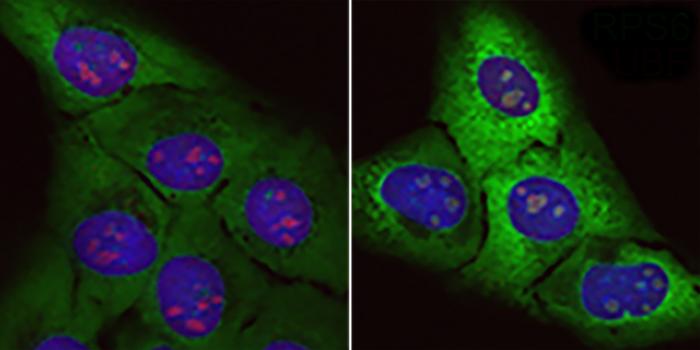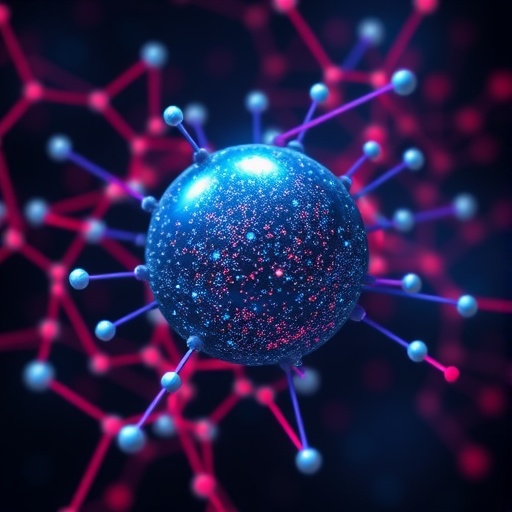Amyotrophic lateral sclerosis (ALS) is a degenerative disease. The neurons responsible for movement begin to die and muscle control is progressively lost, leading to a fatal outcome. The causes of ALS are currently unknown, and there is no effective treatment.

Credit: CNIO
- CNIO researchers provide a new hypothesis to understand the origin of amyotrophic lateral sclerosis, or ALS. It would be triggered by a similar problem to that occurring in a group of rare diseases called ribosomopathies.
- In ALS patients, motor neurons would accumulate an excess of non-functional ribosomal proteins that eventually collapse the cell’s clearance systems and cause toxicity.
- The study also opens a new front in aging research. The authors provide experimental evidence that formally proves a kind of stress called ‘nucleolar stress’ cause aging in mammals.
Amyotrophic lateral sclerosis (ALS) is a degenerative disease. The neurons responsible for movement begin to die and muscle control is progressively lost, leading to a fatal outcome. The causes of ALS are currently unknown, and there is no effective treatment.
In a paper published in Molecular Cell, a team led by Óscar Fernández-Capetillo, head of the Genomic Instability Group at the Spanish National Cancer Research Center (CNIO), provides the first evidence that a possible cause of the hereditary type of ALS –familial ALS– is the accumulation in motor neurons of ‘junk proteins’, proteins with no function that wrongly accumulate and prevent the cell from functioning properly.
Specifically, these non-functional proteins that accumulate are ribosomal proteins, which normally form ribosomes, molecular factories in charge of protein production.
Thus, this study provides a new hypothesis for understanding the origin of ALS, by suggesting that it has a similar origin to another group of rare diseases known as ribosomopathies, also associated with an excess of non-functional ribosomal proteins (in the case of ALS, this problem is restricted to motor neurons).
The new study also opens a new front in a different area, aging research. The authors propose a new causal factor in the aging process, which until now would have been overlooked: nucleolar stress, a mechanism by which organelles called nucleoli react to various damages in the cell.
“In our work we report a new model that explains how nucleolar stress induces toxicity in animal cells, and we provide direct evidence that it accelerates aging in mammals,” Vanesa Lafarga, corresponding co-author of the study says.
A ‘tar’ that blocks RNA
Most patients with hereditary ALS share mutations in a gene called C9ORF72. This mutation results in the production of toxic proteins –or peptides– rich in the amino acid arginine. In a previous work, Fernandez Capetillo’s group took the first steps to understand why these peptides are toxic. The reason is that these toxins stick to DNA and RNA “as if they were tar,” affecting virtually all reactions in the cell that use these nucleic acids.
The study now published in Molecular Cell, with Oleksandra Sirozh as first author, shows that the toxin has a particularly acute effect on the manufacture of new ribosomes, production factories inside the cell, which are made up of RNA and proteins.
ALS as a ribosomopathy
Thus, as they are unable to complete their assembly, “the cell accumulates an excess of orphan ribosomal proteins, incapable of forming ribosomes,” explains Fernández Capetillo. “These proteins end up collapsing the cellular clearance systems, which finally leads to the death of the motor neurons”.
For the authors, this work suggests for the first time a similarity between the cause of ALS and another type of diseases known as ribosomopathies, also associated with the accumulation of dysfunctional ribosomal proteins in a generalized manner in all cells of the human body.
Potential treatment pathway
Based on this finding, the CNIO group has explored a solution. “As the problem is the excess of ribosomal junk, we explored strategies to make cells produce fewer ribosomes,” explains Fernández-Capetillo. To achieve this, they used genetic and pharmacological manipulation to switch off two of the mechanisms that generate ribosomes in tissues in vitro, and found that, by producing less “garbage”, toxicity is actually reduced.
However, Fernández-Capetillo says that these results should be interpreted with caution: “We are in the first steps to see if we can give a therapeutic angle to these findings”. For the moment, these experiments simply indicate “the possible existence of avenues that had not been explored in the search for treatments” against ALS. “We must find ways to reduce the production of ribosomes so that waste decreases, while still keeping a sufficient number to guarantee the correct functioning of the cells.”
A new cause of aging: nucleolar stress
The nucleolus is the cellular component where ribosomes are synthesized. In recent decades it has been observed that one of its functions is also to detect stress situations in the cell, such as DNA damage or lack of nutrients. Nucleolar stress can eventually alter protein production, and its triggers are the object of a very active area of research.
In the work now published in Molecular Cell, the authors generated animals expressing throughout the body the toxin found in ALS patients, which induced severe nucleolar stress. But the researchers also observed, unexpectedly, that these animals aged very rapidly.
Junk proteins accelerate aging
Based on their previous studies, they found that this aging was also due to the accumulation of non-functional ribosomal proteins: when animals were given a drug that reduces the rate of ribosome production, their life expectancy doubled.
There had been speculation about the relationship between nucleolar stress and aging, but it had not been possible to demonstrate a causal relationship. This work “is the first experimental evidence that generating nucleolar stress accelerates aging,” says Fernández Capetillo.
The work has been co-financed by the Ministry of Science, Innovation and Universities, FEDER funds from the European Union, the Spanish Association Against Cancer and the “la Caixa” Foundation in alliance with the Francisco Luzón Foundation.
Journal
Molecular Cell
Method of Research
Experimental study
Subject of Research
Animals
Article Title
Nucleolar stress caused by arginine-rich peptides triggers a ribosomopathy and accelerates aging in mice
Article Publication Date
22-Mar-2024
COI Statement
The authors declare no competing interests.




